
Pontrobert is an ecclesiastical parish that was formed in September 1854. It comprises the townships of Teirtref and part of Nantymeichiaid in the parish Meifod, a portion of Cynhinfa which was in the parish of Llangynyw and portions of the townships of Fachwel, Llaethbwlch and Cadwnfa which were in the parish of Llanfihangel. The total area of this parish is 5,000 acres. As a result of this arrangement, Pont Robert is now divided between the present day Community Councils of Meifod, Llangyniew and Mawddwy. Pontrobert was within the historic county of Montgomeryshire, now forming part of Powys. The name Pontrobert is derived from Robert ap Oliver of Cyhinfa, who built the original bridge over the River Vyrnwy around 1700. An alternative Welsh name for Pontrobert is Pont y ddolfeiniog.

Kea is a civil parish and village in Cornwall, England, United Kingdom. It is a "large straggling parish" in a former mining area south of Truro.
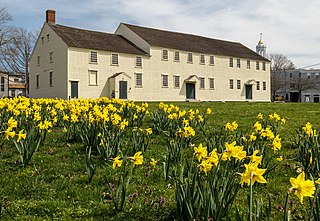
A Friends meeting house is a meeting house of the Religious Society of Friends (Quakers), where meeting for worship is usually held.

The Benjaminville Friends Meeting House and Burial Ground is a Friends Meeting House of the Religious Society of Friends (Quakers), located north of the rural village of Holder in McLean County, Illinois. It was once the site of a now-defunct village called Benjaminville, founded in 1856 after Quakers settled the area. More Quakers followed, and the burial ground, then the current meeting house in 1874, were constructed. This site, listed on the U.S. National Register of Historic Places since 1983, is all that remains of that village.

The Cornwall Friends Meeting House is a historic meeting house located on a 5.4-acre (2.2 ha) parcel of land at the junction of Quaker Avenue and US 9W in Cornwall, New York, United States, near Cornwall-St. Luke's Hospital. It is both the oldest religious building in the town, and the first one built. In 1988 it was added to the National Register of Historic Places as a well-preserved, minimally-altered example of a late 18th-century Quaker meeting house.

The Smith Clove Meeting House is a Quaker place of worship in Highland Mills, New York, United States, a short distance from NY 32 on Smith Clove Road. It is the oldest religious building in the town and village of Woodbury, dating to the beginning of the 19th century, and is still used by the nearby Cornwall Quakers for meetings at least once a year.

The Ifield Friends Meeting House is a Friends meeting house in the Ifield neighbourhood of Crawley, a town and borough in West Sussex, England. Built in 1676 and used continuously since then by the Quaker community for worship, it is one of the oldest purpose-built Friends meeting houses in the world. It is classified by English Heritage as a Grade I listed building, a status given to buildings of "exceptional interest" and national importance. An adjoining 15th-century cottage is listed separately at Grade II*, and a mounting block in front of the buildings also has a separate listing at Grade II. Together, these structures represent three of the 100 listed buildings and structures in Crawley.

The Nine Partners Meeting House and Cemetery is located at the junction of NY state highway 343 and Church Street, in the village of Millbrook, New York, United States. The meeting house, the third one on the site, was built by a group of Friends ("Quakers") from the Cape Cod region, Nantucket and Rhode Island in 1780.
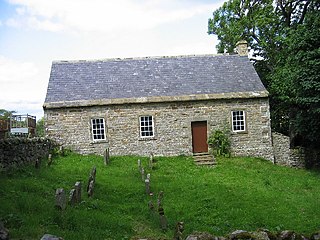
Coanwood Friends Meeting House is a redundant Quaker meeting house under the care of the Historic Chapels Trust. It stands in an isolated, sparsely populated valley south of Hadrian's Wall, in East Coanwood, about 5 miles south of the town of Haltwhistle in Northumberland, England. It is recorded in the National Heritage List for England as a designated Grade II* listed building.

Catherine Phillips, born Payton was a Quaker Minister, who travelled in England, Wales, Scotland, Holland and the American colonies. Her first name is sometimes spelt "Catharine".
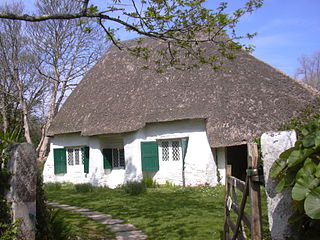
Come-to-Good is a small settlement in Cornwall, England, United Kingdom.

Godalming Friends Meeting House is a Friends meeting house in the ancient town of Godalming in the English county of Surrey. One of many Nonconformist places of worship in the town, it dates from 1748 but houses a congregation whose roots go back nearly a century earlier. Decline set in during the 19th century and the meeting house passed out of Quaker use for nearly 60 years, but in 1926 the cause was reactivated and since then an unbroken history of Quaker worship has been maintained. Many improvements were carried out in the 20th century to the simple brick-built meeting house, which is Grade II-listed in view of its architectural and historical importance.

Preston Patrick is a village and civil parish in South Lakeland, Cumbria, England. It has junction 36 of the M6 motorway in its south west corner and extends north east on both sides of the motorway until just beyond the B2564 road. In the 2001 census the parish had a population of 438, decreasing at the 2011 census to 426.
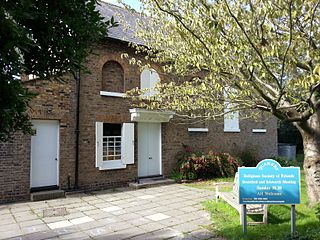
The Brentford & Isleworth Meeting House is a Friends meeting house on Quakers Lane in Isleworth, Hounslow. It is listed Grade II* on the National Heritage List for England, and is one of the oldest purpose-built meeting houses in London. Meeting for worship is held on Sundays at 10:30 am.
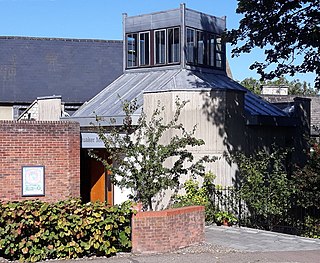
Blackheath Quaker Meeting House is a Grade II listed building in the London Borough of Lewisham. It has been the home of Blackheath Quaker Meeting since 1972, and is also used by many community groups. Designed by Trevor Dannatt, it is believed to be the only Quaker Meeting House in Britain built in the Brutalist style. In the survey of Quaker meeting houses conducted by the Architectural History Practice for Historic England and Quakers in Britain it was described as a "Brutalist jewel" and "of exceptional aesthetic value".
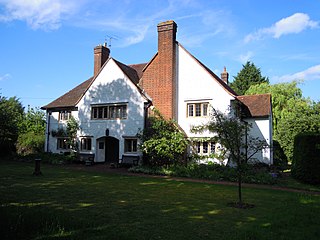
Howgills in Letchworth Garden City, Hertfordshire, England, is a Grade II listed building on the Register of Historic England in use as a Meeting House for the Society of Friends (Quakers).
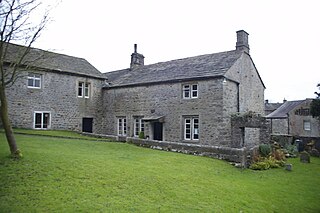
The Airton Quaker Meeting House is a historic religious building in Airton, a village in North Yorkshire, in England.

Lewes Friends Meeting House is a Religious Society of Friends (Quaker) place of worship in the town of Lewes, part of the district of the same name in East Sussex, England. A Quaker community became established in the town in 1655 when George Fox, prominent Dissenter and founder of the Religious Society of Friends, first visited. A meeting house opened in 1675 and a burial ground was erected in 1697. The present meeting house, which is a Grade II listed building, was built in 1784 on the site of the burial ground. The building has undergone "a long and complex history of extensions" and rounds of alterations, including the addition of two cottages and a coach-house. It is one of a wide range of Protestant Nonconformist places of worship in the town, many of which have been established for centuries.

Horsham Friends Meeting House is a Religious Society of Friends (Quaker) place of worship in the town of Horsham, part of the district of the same name in West Sussex, England. It was built in 1786 to replace a meeting house nearly 100 years older on the same site, built for a Quaker community which had been active in the town for several years. "A fine Georgian building with original furnishings", it has Grade II listed status.





















